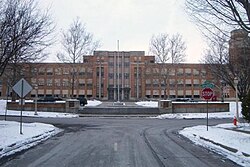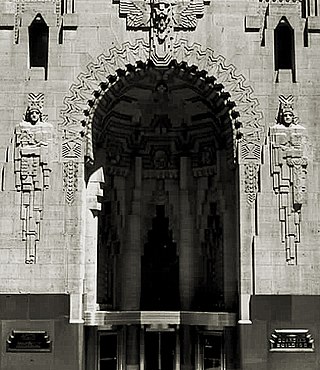
Corrado Giuseppe Parducci was an Italian-American architectural sculptor who was a celebrated artist for his numerous early-20th century works.

Wirt Clinton Rowland was an American architect best known for his work in Detroit, Michigan.

The Guardian Building is a landmark skyscraper and class-A office building in downtown Detroit, Michigan, within the Financial District. Built in 1928 and finished in 1929, the building was originally called the Union Trust Building and is a bold example of Art Deco architecture, including art moderne designs. It was designated a National Historic Landmark in 1989, and is currently owned by Wayne County.

The Edwin C. Denby High School is a public secondary education school located at 12800 Kelly Road in northeastern Detroit, Michigan. Denby High opened in 1930, and the building was listed on the National Register of Historic Places in 2005. It is a part of Detroit Public Schools Community District.

The Buhl Building is a skyscraper and class-A office center in Downtown Detroit, Michigan. Architect Wirt C. Rowland designed the Buhl in a Neo-Gothic style with Romanesque accents. Constructed in 1925, it stands at 26 stories in the Detroit Financial District across Congress Street from the Penobscot Building and across Griswold Street from the Guardian Building, all of which were designed by Wirt C. Rowland. The Buhl Building stands on the corner of Congress St. West, and Griswold St. in Downtown Detroit. The building stands atop what used to be the Savoyard Creek near its confluence with the Detroit River. In 1836, the creek was covered and turned into a sewer. The Savoyard Club occupied the 27th floor of the Buhl Building from 1928 until its membership dwindled and the club closed in 1994.

The David Stott Building is a 38 story high-rise apartment building with office space on floors 2-6 and retail space on the first floor. The "Stott" was originally built as a class-A office building located at 1150 Griswold Street in Downtown Detroit, Michigan, within the Capitol Park Historic District. It was designed in the Art Deco style by the architectural firm of Donaldson and Meier and completed in 1929. Bedrock Detroit owns and manages the building which began leasing in late 2018 and includes 107 apartment homes and 5 floors of commercial office space.

The Coleman A. Young Municipal Center (CAYMC) is a government office building and courthouse in downtown Detroit, Michigan. Originally called the City-County Building, it was renamed for the former Detroit Mayor Coleman A. Young, shortly after his death in 1997. It houses the headquarters of the government of the City of Detroit, as well as offices of the Wayne County government.

The AT&T Michigan Headquarters is a complex of skyscrapers and buildings located at 1st Street, Cass Avenue, State Street, and Michigan Avenue in Downtown Detroit, Michigan. It contains the AT&T Building, the AT&T Building addition, the Maintenance Shop and is owned by communications giant AT&T.
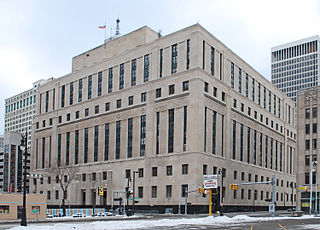
The Theodore Levin United States Courthouse is a large high-rise courthouse and office building located at 231 West Lafayette Boulevard in downtown Detroit, Michigan. The structure occupies an entire block, girdled by Shelby Street (east), Washington Boulevard (west), West Fort Street (south), and West Lafayette Boulevard (north). The building is named after the late Theodore Levin, a lawyer and United States District Court judge.

The Cultural Center Historic District is a historic district located in Detroit, Michigan, which includes the Art Center : the Detroit Public Library, the Detroit Institute of Arts, and the Horace H. Rackham Education Memorial Building were listed on the National Register of Historic Places in 1983. The district contains several cultural attractions.

The Players is a clubhouse and theatre located at 3321 East Jefferson Avenue in Detroit, Michigan. It was designated a Michigan State Historic Site in 1985 and listed on the National Register of Historic Places in 1987.

The Rivoli Theatre in South Fallsburg, New York, United States is located at the intersection of NY 42 and Laurel Avenue. It was built in 1923, renovated in the late 1930s and remains almost intact from that period.

The U.S. Post Office and Courthouse, also known as the Galveston Federal Building, is a post office and courthouse located in Galveston, Texas, USA. The building serves as the federal court for the Galveston Division of the United States District Court for the Southern District of Texas. Constructed in 1937, and added to the National Register of Historic Places in 2001 as Galveston U.S. Post Office, Custom House and Courthouse, the building is home a number of federal agencies, and at one point housed the Galveston Bureau of the National Weather Service.
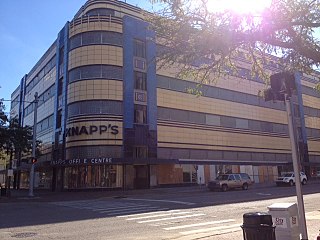
The J.W. Knapp Company Building is a historic five-story, 190,000-square-foot (18,000 m2) Streamline Moderne building in Lansing, Michigan, United States. Designed by Orlie Munson of the Bowd–Munson Company, which also designed several other Art Deco landmarks in Lansing, including the Ottawa Street Power Station, it was constructed by the Christman Company in 1937 through 1938. The curvilinear look of the streamlined structure comes from huge plates of concrete faced with enamel, called "Maul Macotta", a copyrighted product of the Maul Macotta Company and prismatic glass brick windows. Alternating horizontal bands of yellow macotta and glass block are interrupted by vertical blue macotta pylons, rising from the building's four principal entrances. The pylons are pierced by windows. The entrance portals, display window aprons, and decorative banding are dark blue macotta. Red, yellow and blue spandrels, incorporating the letter "K" as a design element, decorate the entrance portals.

The Jenkins Music Company Building is a historic building in the Kansas City Power and Light District in Kansas City, Missouri. Built in 1911, it is a significant example of unaltered, Modernistic style commercial architecture, combining Late Gothic Revival and Art Deco decorative elements. It was listed on the National Register of Historic Places in 1979.

Chateau Nous is a heritage-listed villa at 1 Rupert Terrace, Ascot, Queensland, Australia. It was designed by Douglas Francis and Woodcraft Roberts. It was built from c. 1937 to 1940s. It was added to the Queensland Heritage Register on 21 October 1992.

The Federal Building and United States Courthouse is located in Sioux City, Iowa, United States. The present city hall in Sioux City was previously the post office, federal building and courthouse. This building replaced it. It was designed by the local architectural firm of Beuttler & Arnold with the Des Moines firm of Proudfoot, Rawson, Souers & Thomas providing input and oversight. Construction began in 1932 under the direction of the Acting Supervising Architect of the Treasury James A. Wetmore. The building was dedicated on December 29, 1933. The Federal Government had paid $270,000 for the property, and about $725,000 on construction. Architecturally, the three-story, stone structure is a combination of Stripped Classicism and Art Deco. The post office moved to a new facility in 1984, and additional office space and a new courtroom were created in the building. A further renovation was undertaken from 1999 to 2000 and a third courtroom a judge's chamber, jury deliberation room, library, and holding cell for defendants were added. The building was listed on the National Register of Historic Places in 2013.
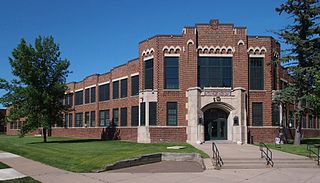
Franklin Junior High School is a historic former school building in Brainerd, Minnesota, United States. The core sections were built in 1932 and extensions were added on in 1954 and 1962. The school closed in 2005. In 2008 the building reopened as the Franklin Arts Center, which leases residential, work, and commercial space to local artists.

The Gillette-Tyrrell Building is a building in downtown Tulsa, Oklahoma. It was begun in 1929 by two Tulsa oilmen, J. M. Gillette and H. C. Tyrrell. They initially planned to construct a three-story office building at 432 S. Boulder Avenue, topped by a ten-story hotel, but these plans were canceled during the Great Depression and they stopped construction at the third floor. In 1931, they sold it to the Knights of Pythias, who decided to complete it as an office building and renamed it the Pythian Building.

The Madison Belmont Building, also known as 183 Madison Avenue, is a commercial building at the southeast corner of Madison Avenue and 34th Street in Murray Hill, Manhattan, New York. It was designed by Warren & Wetmore in the Neoclassical style and built in 1924–1925. The Madison Belmont Building has a "transitional" design that deviates from Warren & Wetmore's other commissions, combining elements of the Neoclassical style and more modern influences from the Art Deco style.
